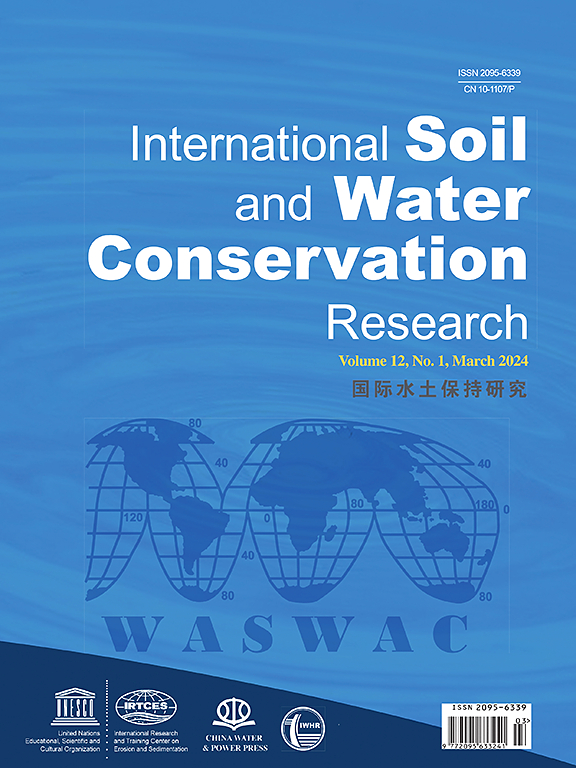Economic comparison of conventional and conservation tillage in a long-term experiment: Is it worth shifting?
IF 7.3
1区 农林科学
Q1 ENVIRONMENTAL SCIENCES
International Soil and Water Conservation Research
Pub Date : 2025-03-04
DOI:10.1016/j.iswcr.2025.02.012
引用次数: 0
Abstract
There is considerable knowledge regarding the environmental benefits of conservation agriculture (CA). However, long-term profitability data are limited, despite their potential to drive CA adoption. This study analyses and compares the economic indicators of conservation reduced tillage (CT) widely practiced in Central Europe with those of conventional ploughing tillage (PT). This research investigated the costs and incomes under CT and assessed the impact of CT on crop yields and profitability over a 20-year period (2004–2023). The study covered 83 ha in 10 paired plots (from year 13 onwards, 76 ha in 9 paired plots), including extreme weather conditions and 6 crops. All annual data were adjusted to 2024 price levels to maintain consistency. Piecewise linear regression was applied to the data, revealing four distinct temporal phases. On the basis of profit, periods ‘Transitional’ (years 1–3), ‘Adapted 1’ (years 4–10), ‘Steady’ (years 11–17) and ‘Adapted 2’ (years 18–20) were separated. During the transitional period, profit under CT decreased by an average of 11.9% compared with PT, but subsequent periods indicated positive results. Therefore, the shift from year 7 onwards resulted in a profit increase. Over 20 years, material costs for CT plots were 1.9% higher and operating costs were 9.8% lower compared with PT. In addition, gross income increased by 2.3%, leading to a 13.0% higher profit on CT compared with PT plots, which could encourage wider adoption of CT by farmers.
长期试验中传统耕作与保护性耕作的经济比较:是否值得改变?
关于保护性农业(CA)的环境效益有相当多的知识。然而,长期盈利数据是有限的,尽管它们有可能推动CA的采用。本文对中欧地区广泛采用的保护性减量耕作(CT)与传统耕作(PT)的经济指标进行了分析比较。本研究调查了CT下的成本和收入,并评估了CT在20年期间(2004-2023年)对作物产量和盈利能力的影响。该研究覆盖了10个成对地块83公顷(从13年级开始,9个成对地块76公顷),包括极端天气条件和6种作物。所有年度数据均调整为2024年的价格水平,以保持一致性。将分段线性回归应用于数据,揭示了四个不同的时间阶段。在利润的基础上,“过渡期”(1 - 3年)、“适应期”(4-10年)、“稳定期”(11-17年)和“适应期2”(18-20年)被分开。在过渡期间,CT项下的利润与PT相比平均下降11.9%,但随后的时期均为积极的结果。因此,从第7年开始的转移导致利润增加。20年间,CT田的材料成本比PT高出1.9%,运营成本比PT低9.8%。此外,总收入增加2.3%,导致CT田的利润比PT田高13.0%,这可以鼓励农民更广泛地采用CT。
本文章由计算机程序翻译,如有差异,请以英文原文为准。
求助全文
约1分钟内获得全文
求助全文
来源期刊

International Soil and Water Conservation Research
Agricultural and Biological Sciences-Agronomy and Crop Science
CiteScore
12.00
自引率
3.10%
发文量
171
审稿时长
49 days
期刊介绍:
The International Soil and Water Conservation Research (ISWCR), the official journal of World Association of Soil and Water Conservation (WASWAC) http://www.waswac.org, is a multidisciplinary journal of soil and water conservation research, practice, policy, and perspectives. It aims to disseminate new knowledge and promote the practice of soil and water conservation.
The scope of International Soil and Water Conservation Research includes research, strategies, and technologies for prediction, prevention, and protection of soil and water resources. It deals with identification, characterization, and modeling; dynamic monitoring and evaluation; assessment and management of conservation practice and creation and implementation of quality standards.
Examples of appropriate topical areas include (but are not limited to):
• Conservation models, tools, and technologies
• Conservation agricultural
• Soil health resources, indicators, assessment, and management
• Land degradation
• Sustainable development
• Soil erosion and its control
• Soil erosion processes
• Water resources assessment and management
• Watershed management
• Soil erosion models
• Literature review on topics related soil and water conservation research
 求助内容:
求助内容: 应助结果提醒方式:
应助结果提醒方式:


